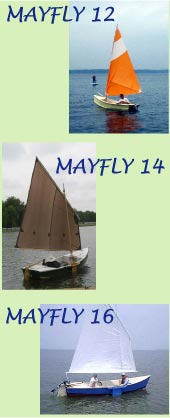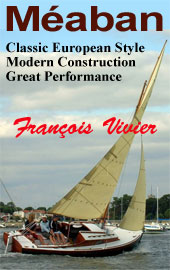
 Custom Search
|
| boat plans |
| canoe/kayak |
| electrical |
| epoxy/supplies |
| fasteners |
| gear |
| gift certificates |
| hardware |
| hatches/deckplates |
| media |
| paint/varnish |
| rope/line |
| rowing/sculling |
| sailmaking |
| sails |
| tools |
| join |
| home |
| indexes |
| classifieds |
| calendar |
| archives |
| about |
| links |
| Join Duckworks Get free newsletter CLICK HERE |
|
|
| Joansa |
by John Welsford - Auckland, New Zealand |
I was short of boats, the cost of keeping her on a mooring, antifouling and all the other maintenance had become too much to bear so I’d sold my big yacht. How to get out on the water next summer? That was the big question. I like rowing, camp cruising in a rowing boat is like backpacking without having to carry the load on your back, easier on the feet as well. Some people think its hard work, but when I ask them, more often than not, they’ve never rowed a really nice rowing boat, so don’t realise how easily they move. With only a couple of months of part time available to get a boat built before the good weather arrived, my new boat had to be simple to build, had to carry a good load, be capable enough to take me cruising in somewhat open waters and be fast enough to make 20 miles or so when the tide was running with me. The dory style of boat with its bottom panel substituting for a keel suits plywood construction, and some of the round sided rowing dories from the East Coast of the USA are quite graceful. After some reading, I settled on a modern interpretation of the Amesbury Skiff, native to the town of that name on the Merrimac river in Massachusets. Slim, light, easily driven boats that will cope with some rough water, these seemed to be close to what I needed. In plywood the boat would be much lighter, and I proposed to build a slightly smaller boat which would still carry the load I proposed, but which would be practical to carry on a small cars roof rack which meant I wouldn’t have to part with dollars to buy a trailer. I drew the boat out, pulled some plywood out of the rack and added construction details to the plans as I went, and by the time I had her ready for the water I had about 50 hours invested in her.
Credit, all pics courtesy of Alan Thorne. We did cruise that summer, my wife came along in her Kayak, me carrying our 6 year old daughter in the sternsheets and our camping gear spread under the seats along with the 2hp Honda outboard I took for insurance if we had to make a run for it to beat the weather. Since then there have been a couple of hundred sets of plans sold, she’s popular, the ease of construction making her achievable by novice builders and her performance enlightening many who now know what its like to feel the easy surge when the oars are pulled through, and who enjoy the gentle exersize that a really nice rowing boat can give. Just recently I had an email from Alan Thorne who lives near the coast in the south of England. He has been running courses on boatbuildng for school kids and they’ve built a particularly nice example of my design. He was good enough to send me some pictures of the build and of the finished boat. It looks as though those young people can be very proud of their efforts. Here is a clip from his email which will tell some of the story.
My answer was yes, do make patterns when building the first one which will speed up the second and subsequent builds a lot, and told him that, as he was using the builds to teach, if there were two built there would be no charge for the second one. The job was done, and we have here a selection of pictures of the first build. Alan and his crew have done a particularly nice job of their boat, she’s beautiful, fair and very nicely finished. Here’s a quote from his email:
It’s a privilege to be the designer who was chosen by Alan, an the result is a real credit to him. Thanks Alan. The plans for Joansa are available in the Duckworks Store. Joan, Thank you Alan for the pics and the positive comments, give my regards to your students and all the very best with the course. |
To comment on Duckworks articles, please visit one of the following:
|
 |













